|
The Pre Industrial Era 1900-1926 The first logic built into calculating machines. Calculators got more and more business oriented and
were no longer for scientists only but business people as well. |
pre history | antiquity
| pre industrial era | industrial
era
1886 -
1900 - 1927
- 1938 - 1940 - 1944
| Related Articles |
| Related Resources |
|
|
![]() Leonardo
Torres y Quevedo built two electro mechanical chess machines that could
play the endgame of king and tower against a tower. But he saw no future in
it because, like Babbage, he felt restricted by the mechanical constraints and
tolerances
that could not be met at the time.
Leonardo
Torres y Quevedo built two electro mechanical chess machines that could
play the endgame of king and tower against a tower. But he saw no future in
it because, like Babbage, he felt restricted by the mechanical constraints and
tolerances
that could not be met at the time.
![]() Herman Hollerith
introduced an automatic punch card feeder that processed the census of 1900
a lot faster.
Herman Hollerith
introduced an automatic punch card feeder that processed the census of 1900
a lot faster.
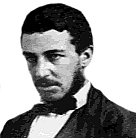
![]() The
first calculator that solved a problem faster than it could be done by hand,
was Jevons' Logical Piano.
The
first calculator that solved a problem faster than it could be done by hand,
was Jevons' Logical Piano.
The elements for logical automata already existed - for example the self-regulating machines using "feedback". These machines could be programmed by punched cards and tape.
![]() Writers were
venturing into the future. Samuel Butler began his
novel, Erewhon, with an essay entitled "Darwin Among
the Machines."
Writers were
venturing into the future. Samuel Butler began his
novel, Erewhon, with an essay entitled "Darwin Among
the Machines."
![]() Allan Marquand,
a Princeton professor, developed a machine that solved very simple logic problems.
Below is the picture of its "output screen"
Allan Marquand,
a Princeton professor, developed a machine that solved very simple logic problems.
Below is the picture of its "output screen"
![]() In his correspondence
the philosopher, Charles S. Pierce, showed a
deep insight into what machines could be.
In his correspondence
the philosopher, Charles S. Pierce, showed a
deep insight into what machines could be.
In commenting on Marquand's machine, Pierce suggested that a system of batteries
and switches could be hooked up to solve very difficult problems in formal logic.
This would include most of the theorems of algebra and geometry. This was almost
like the basic idea to the modern computer: "All arithmetic operations
have electrical counterparts".
![]() Max
Planck described the quantum effect. This theory will become very important
in later developments of micro processors. The development of quantum computers
would have been unthinkable without this theory.
Max
Planck described the quantum effect. This theory will become very important
in later developments of micro processors. The development of quantum computers
would have been unthinkable without this theory.
![]() Marconi
organized the first Trans Atlantic radio broadcast from Newfoundland
Marconi
organized the first Trans Atlantic radio broadcast from Newfoundland

![]() The
Dalton, introduced in 1902, was the first adding machine to use a ten-key keyboard.
The layout, however, differed somewhat from today's standard as the digits 2,
4, 5, 7, 9 were in the top row, and 1, 3, 0, 6, 8 in the bottom row. The same
keyboard layout was used in the Facit calculators.(21)
The
Dalton, introduced in 1902, was the first adding machine to use a ten-key keyboard.
The layout, however, differed somewhat from today's standard as the digits 2,
4, 5, 7, 9 were in the top row, and 1, 3, 0, 6, 8 in the bottom row. The same
keyboard layout was used in the Facit calculators.(21)
![]() A
young electrical engineer called Frank Pearne is approached by Mr. Joy Morton,
the president of the Morton Salt Company. Pearne has been experimenting with
printing telegraphs and needed a sponsor. Morton discuss the situation with
his friend and mechanical engineer Charles L. Krum, and they decide in favor
of this project.
A
young electrical engineer called Frank Pearne is approached by Mr. Joy Morton,
the president of the Morton Salt Company. Pearne has been experimenting with
printing telegraphs and needed a sponsor. Morton discuss the situation with
his friend and mechanical engineer Charles L. Krum, and they decide in favor
of this project.
After a year of unsuccessful experiments, Pearne looses interest and wanders
off into the sunset to become a teacher. Krum will continue to investigate the
telegraph mechanism and is joined by his son Howard in 1906. In 1910 they will
deliver a working telegraph system.

![]() Willbur
en Orvile Wright construct the first mechanical airplane. Man becomes
airborne.
Willbur
en Orvile Wright construct the first mechanical airplane. Man becomes
airborne.
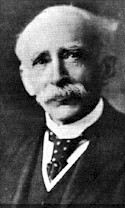
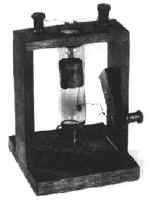
![]() John
Ambrose Fleming files a patent for the first vacuum tube: a diode.(17)
John
Ambrose Fleming files a patent for the first vacuum tube: a diode.(17)
![]() Einstein
described his theory of relativity, a new way of thinking started in the scientific
community.
Einstein
described his theory of relativity, a new way of thinking started in the scientific
community.
A turning point in thinking! Spurting scientists towards further development in mathematics, physics and astronomy. Following from this developments it leads to the atomic bomb, possibility of space flights is no longer a Jules Verne's phantasy, and the theory of probability further prospered. Just to name a few.
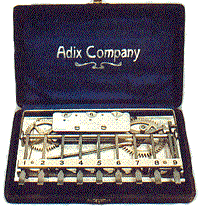
![]() The
first use of aluminum in calculators was in the Adix company's "pocket"
calculator. The bars inside the case were of aluminum that kept the weight down.
The case is lined with blue velvet.
The
first use of aluminum in calculators was in the Adix company's "pocket"
calculator. The bars inside the case were of aluminum that kept the weight down.
The case is lined with blue velvet.
![]() Lee
DeForest (USA) introduced a third electrode called "the grid"
into the vacuum tube and called it: "Triode". This triode was mainly
used as a component for amplifiers but it served as an electronic switch as
well and replaced the electro mechanical relays which revolutionized computing.
He filed for a patent the next year.(12) Without this invention
it would be impossible to design digital electronic computers. (15)
Lee
DeForest (USA) introduced a third electrode called "the grid"
into the vacuum tube and called it: "Triode". This triode was mainly
used as a component for amplifiers but it served as an electronic switch as
well and replaced the electro mechanical relays which revolutionized computing.
He filed for a patent the next year.(12) Without this invention
it would be impossible to design digital electronic computers. (15)
![]() The desk calculator
by Brunsviga (approximately 1906) was introduced. The
calculating mechanism was based on the principle of the stepped cylinder designed
by Odhner. This device will be the father of all office
desk calculators.
The desk calculator
by Brunsviga (approximately 1906) was introduced. The
calculating mechanism was based on the principle of the stepped cylinder designed
by Odhner. This device will be the father of all office
desk calculators.
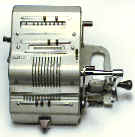
![]() Henry Babbage,
Charles Babbage's son, with
support from R. W. Munro's firm, completed the mill of his father's Analytical
Engine, just to show that it would have worked, and it did! The complete machine
however will never be produced.(15)
Henry Babbage,
Charles Babbage's son, with
support from R. W. Munro's firm, completed the mill of his father's Analytical
Engine, just to show that it would have worked, and it did! The complete machine
however will never be produced.(15)
The London Science Museum will start to reconstruct this analytical engine in
the late 20th century.
![]() L.
Torres developed a formal language to describe machines. This will be used
later by Claude Shannon
in his Information Theorem.
L.
Torres developed a formal language to describe machines. This will be used
later by Claude Shannon
in his Information Theorem.
![]() The Austrian
physicist Robert von Lieben filed patents for
an electronic tube in 1907 and 1910(11);
one of the original tubes can be seen at the Technisches Museum Wien
The Austrian
physicist Robert von Lieben filed patents for
an electronic tube in 1907 and 1910(11);
one of the original tubes can be seen at the Technisches Museum Wien
![]() Lee
de Forest also filed a patent for vacuum tubes,(12) an
invention he made a year earlier.
Lee
de Forest also filed a patent for vacuum tubes,(12) an
invention he made a year earlier.
Again a fine example for the need of something to be invented. And this invention
happened in two separate places by two different inventors.
By the time the judicial system in the USA was in place to protect ones inventions
many court cases were fought out over who invented what. An example of this
is Atanasoff versus Mauchly on who invented the Electronic Binary computer,
Atanasoff won after a legal battle of over 15 years.
![]() First C-T-R
Tabulating Machine was produced(13)
First C-T-R
Tabulating Machine was produced(13)
![]() Alan Archibald
Campbell Swinton proposes an electronic system of photography, it will take
about 25 years to make a practical system.(19)
Alan Archibald
Campbell Swinton proposes an electronic system of photography, it will take
about 25 years to make a practical system.(19)
![]() Henry
Prevost, the youngest son of Charles Babbage, completed a calculator that
was based on his father's analytical engine.
He worked on this intermittently from his father's death in 1871. This manually
operated machine could do the four basic calculations of adding, subtracting,
division and multiplication and also print the results. He published after completion
of his machine a table of multiples of the number pi with a 28 digit precision.
A remarkable result in this time.
Henry
Prevost, the youngest son of Charles Babbage, completed a calculator that
was based on his father's analytical engine.
He worked on this intermittently from his father's death in 1871. This manually
operated machine could do the four basic calculations of adding, subtracting,
division and multiplication and also print the results. He published after completion
of his machine a table of multiples of the number pi with a 28 digit precision.
A remarkable result in this time.
![]() The mechanical
and electrical talents of Krum Senior and Junior complemented each other. And
after solving the problem of synchronizing the transmitter and receiver, they
will see their first installation on postal lines between New York City and
Boston in the summer of 1910.(14) The telegraph will be a
fact and it will be one of the major developments that will speed up economic
growth.
The mechanical
and electrical talents of Krum Senior and Junior complemented each other. And
after solving the problem of synchronizing the transmitter and receiver, they
will see their first installation on postal lines between New York City and
Boston in the summer of 1910.(14) The telegraph will be a
fact and it will be one of the major developments that will speed up economic
growth.
This technology will prove to be crucial in the development of the telephone
and thus (remote) communication between computers.
![]() Heinke
Kamerlingh Onnes (the Netherlands), together with Mr. Dorsman
and Mr. Holst, reports to the Royal Academy of Sciences
(Koninklijke Academie van Wetenschappen) on the 27th of May, that they
have discovered the properties of Super
conductivity of Hydrogenium at a temperature of 4.3K (0 Kelvin = -273 Celsius).
No theoretical thesis was developed at that time, and no one knows what to do
with it yet.
Heinke
Kamerlingh Onnes (the Netherlands), together with Mr. Dorsman
and Mr. Holst, reports to the Royal Academy of Sciences
(Koninklijke Academie van Wetenschappen) on the 27th of May, that they
have discovered the properties of Super
conductivity of Hydrogenium at a temperature of 4.3K (0 Kelvin = -273 Celsius).
No theoretical thesis was developed at that time, and no one knows what to do
with it yet.
![]() Hollerith's
company - Tabulating Machine Company - merged with two other companies
to Computing Tabulating Recording
Company. Below the logo of that company.
Hollerith's
company - Tabulating Machine Company - merged with two other companies
to Computing Tabulating Recording
Company. Below the logo of that company.
![]()
Eventually this will become IBM - International Business Machine Corporation in 1924. De new firm produced not only calculators but also weighing machines and time clocks.
![]() Bertrand
Russel and Alfred North Whitehead published their three-volume Principia Mathematica
an influential work on the foundations of mathematics that provided a new methodology
for all mathematics.(17)
Bertrand
Russel and Alfred North Whitehead published their three-volume Principia Mathematica
an influential work on the foundations of mathematics that provided a new methodology
for all mathematics.(17)
![]() Tokuji
Hayakawa founded a steel factory in Tokyo. From the mechanical pencil in 1915
- always sharp- the name of the Sharp company is derived
Tokuji
Hayakawa founded a steel factory in Tokyo. From the mechanical pencil in 1915
- always sharp- the name of the Sharp company is derived
![]() A.
Meisner invented the vacuum tube radio transmitter(17)
A.
Meisner invented the vacuum tube radio transmitter(17)
![]() Charles
P. R. Macaulay constructs a logical machine to solve logical problems.(20)
Charles
P. R. Macaulay constructs a logical machine to solve logical problems.(20)
|
  |
![]() Albert
Einstein completed his theory of gravitation known as the general theory of
relativity
Albert
Einstein completed his theory of gravitation known as the general theory of
relativity
Karel Capek (Czech) called these powerful beings "robota" meaning forced and slavishly work. He distinguishes the robot from man by the absence of emotion.(2) |
 |
|
 |
 |
W. H. Eccles and F.W. Jordan discover that two triode valves could be connected to form a circuit possessing two stable states - the basis for the so-called flip-flop. This construction is capable of storing binary information (14) (15) providing the fundaments for digital computing.
|
![]() The proton
discovered, the proton makes up the atomic nucleus together with the neutron
and is the positive part of the nucleus.
The proton
discovered, the proton makes up the atomic nucleus together with the neutron
and is the positive part of the nucleus.
![]() Norton Hinckley
and Dave Tandy put their money, earned in a leather factory in Dallas, into
the founding of the Hinckley-Tandy Leather Company. Later this will be the Tandy
Corporation manufacturing affordable computers for consumers.
Norton Hinckley
and Dave Tandy put their money, earned in a leather factory in Dallas, into
the founding of the Hinckley-Tandy Leather Company. Later this will be the Tandy
Corporation manufacturing affordable computers for consumers.
![]() The Dutchman
Hugo Koch invented a machine capable of encrypting messages.
The Dutchman
Hugo Koch invented a machine capable of encrypting messages.
The input was done via a keyboard, the machine then produced encoded text at the output side. The difference between this and other coding machines was that the same letter would not necessarily encode into the same character every time. For example, suppose you typed the letter 'a', and 'g' came out at the other side. The next time you typed 'a', an 'u' might come out, rather than the 'g' that you expected. This made enciphered text very difficult to decrypt, since frequency analysis solved nothing. But Koch found little interest in his machine, and so he sold it to a German engineer named Dr. Arthur Scherbius. The latter improved the machine, and began to seek out interested parties. He renamed the machine to "Enigma", and was able to sell it to the German government. At first the German military were reluctant to put the Enigma into use(1) but soon the possibilities were recognized.
![]() The first cash
register that prints numbers is introduced on the market by C-T-R (later IBM).
The first cash
register that prints numbers is introduced on the market by C-T-R (later IBM).
![]() Leonardo Torres
y Quevedo built a calculator that used a type writer for the in- and output.(18)
Leonardo Torres
y Quevedo built a calculator that used a type writer for the in- and output.(18)
![]() In
Boston a radio station RadioShack was set-up. In 1940 this firm will publish
its first mail order catalog
In
Boston a radio station RadioShack was set-up. In 1940 this firm will publish
its first mail order catalog
![]() Vladimir
Kosma Zworkin gave the first demonstration of an electronic television camera
tube.
Vladimir
Kosma Zworkin gave the first demonstration of an electronic television camera
tube.
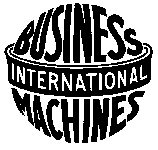
![]() Mar 5, International
Business Machines (IBM corporation) is formed after more mergers involving the
Computing - Tabulating - Recording Company - see 1911.
Mar 5, International
Business Machines (IBM corporation) is formed after more mergers involving the
Computing - Tabulating - Recording Company - see 1911.
By 1990 IBM will have an income of around $69 Billion (and 373,816 employees). The 1992 recession will cause a cut in stock dividends (for the first time in the company's history) and the sacking of 40,000 employees. (15)

![]() In
different countries and by different manufacturers simular calculators with
the four basic functions (+-/*) are manufactured. One of these types is shown
above: the Brunsviga. Other makes are a.o. Odhner, Giessler, and Gauss; all
build on the same principle: stepped gear. The machines are much more sophisticated
then the original Odhner from 1904
In
different countries and by different manufacturers simular calculators with
the four basic functions (+-/*) are manufactured. One of these types is shown
above: the Brunsviga. Other makes are a.o. Odhner, Giessler, and Gauss; all
build on the same principle: stepped gear. The machines are much more sophisticated
then the original Odhner from 1904
![]() The
first television receiver based on the principle of the Braun's
tube was demonstrated in Germany. Until the beginning of the 21st century
this will be the main technology to view data directly from the computer. It
will be called CRT (Cathode Ray Tube) or Computer Screen.
The
first television receiver based on the principle of the Braun's
tube was demonstrated in Germany. Until the beginning of the 21st century
this will be the main technology to view data directly from the computer. It
will be called CRT (Cathode Ray Tube) or Computer Screen.
![]() Mathematicians have been fascinated
by primes for centuries. Prime numbers are unusual numbers that can only be
divided by one or themselves. The numbers 1,3,5,7,11,13,17,19, ... etc. are
such prime numbers.
Mathematicians have been fascinated
by primes for centuries. Prime numbers are unusual numbers that can only be
divided by one or themselves. The numbers 1,3,5,7,11,13,17,19, ... etc. are
such prime numbers.
 Mathematicians in the future looking to solve complicated problems in number
theory just crank up a computer. But that wasn't an option during this period.
At the University of California's Derek Lehmer did his computing on a mechanical
computer designed by him from bicycle chains and sprockets. Derek Lehmer --
whose interest was finding prime numbers and solving equations -- built mechanical
aids to help him do the number crunching.
Mathematicians in the future looking to solve complicated problems in number
theory just crank up a computer. But that wasn't an option during this period.
At the University of California's Derek Lehmer did his computing on a mechanical
computer designed by him from bicycle chains and sprockets. Derek Lehmer --
whose interest was finding prime numbers and solving equations -- built mechanical
aids to help him do the number crunching.
 Left the bicycle chains and electric motor helped Professor Lehmer to track
down prime numbers.
Left the bicycle chains and electric motor helped Professor Lehmer to track
down prime numbers.
 The bicycle chain contraption used a concept called the "number sieve,"
which was first laid out by the Greek thinker Eratosthenes in 200 BC.
The bicycle chain contraption used a concept called the "number sieve,"
which was first laid out by the Greek thinker Eratosthenes in 200 BC.
Lehmer went on to build other number sieves. One of them used 16 millimeter film strips, and another used metal gears. The machines were capable of performing 300,000 mathematical tests a minute. Today's computers do that in fractions of a second.
 Before Lehmer put those chains to work, his father had painstakingly punched
holes in sheets of paper -- using the patterns to search for prime numbers.
It wasn't glamorous work. You would wonder what they were thinking while they
were doing this because they had to wait so long to get the answer, and think
about how easy it would be to make a mistake.
Before Lehmer put those chains to work, his father had painstakingly punched
holes in sheets of paper -- using the patterns to search for prime numbers.
It wasn't glamorous work. You would wonder what they were thinking while they
were doing this because they had to wait so long to get the answer, and think
about how easy it would be to make a mistake.
 Derek Lehmer went on to deliver many lectures describing his low-tech number
crunchers. The machines have now become museum pieces. And, today, people marvel
at what they could do long before computers changed the world of mathematics.
Derek Lehmer went on to deliver many lectures describing his low-tech number
crunchers. The machines have now become museum pieces. And, today, people marvel
at what they could do long before computers changed the world of mathematics.
There's been a close connection between the world of computers and prime numbers. Mathematicians still log countless hours on supercomputers searching for primes since prime numbers are the basis for super-secure codes that protect digital data.(7)
![]() Lilienfeld patents the first
semiconductor as a device for amplification.(8)
Lilienfeld patents the first
semiconductor as a device for amplification.(8)
![]()
| Last Updated on October 4, 2004 | For suggestions please mail the editors |
Notes & References